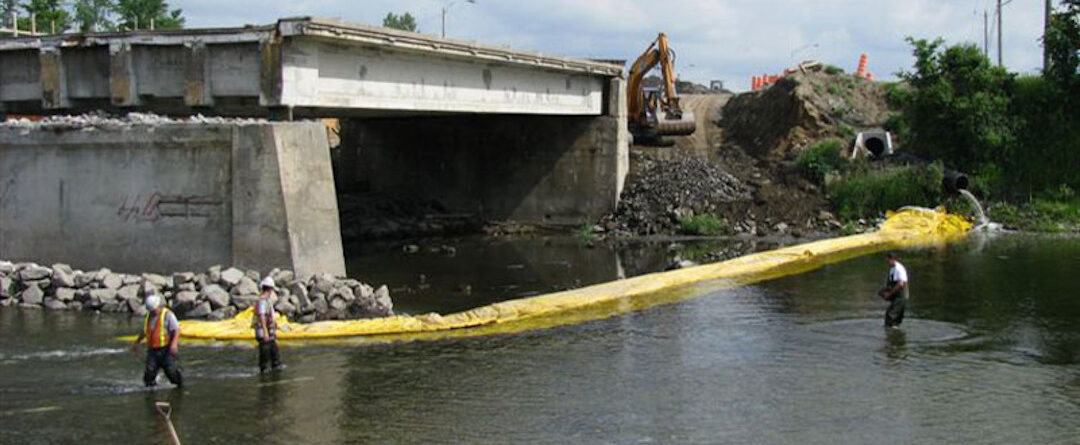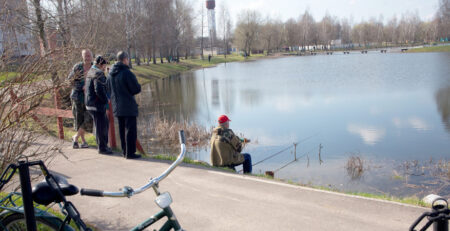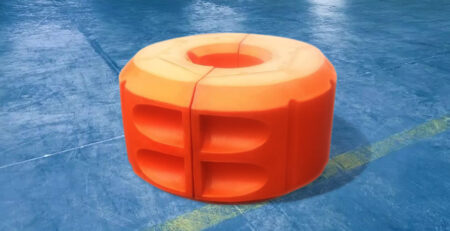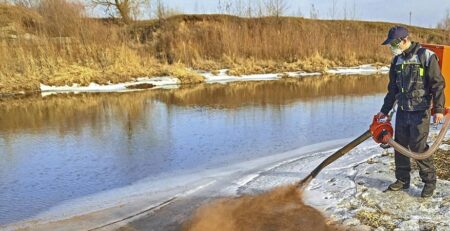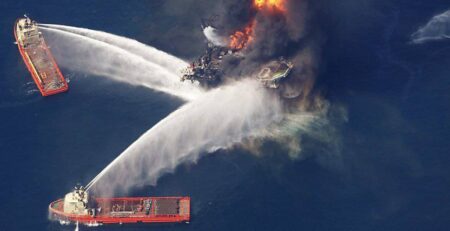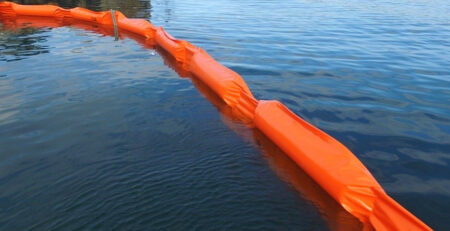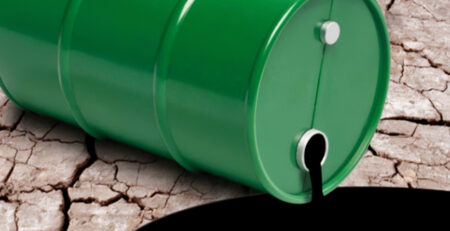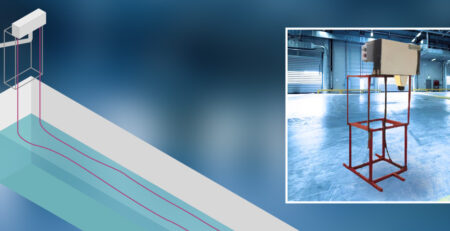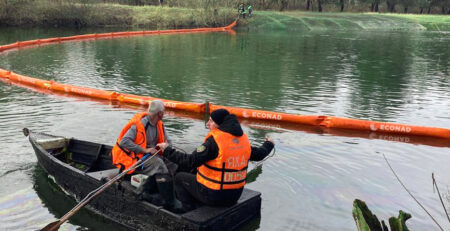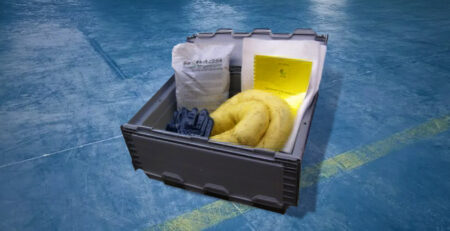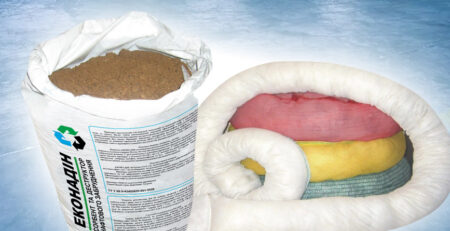Implementation of environmental eco-nad-biotechnologies at oil and gas facilities. Future Perspective
Soloviev V.I.
Kozhanova G.A., Gudzenko T.V., Belyaeva T.V.
Information is given about the new generation biopreparation “Econadin” – a sorbent and destructor of oil hydrocarbons, its distinctive features and advantages in comparison with other bacterial preparations intended for the elimination of oil pollution. Methodical methods of using “Econadin” in complex schemes for the elimination of oil pollution of water and soil have been developed. These “econadine” technologies are essentially close to natural ones. The presented results of their use at the oil and gas facilities indicate the priority nature of environmental biotechnological developments.
Key words: oil pollution, biotechnology, destructor bacteria, “econadine” technologies.
The environmental problems associated with oil pollution are geopolitical in nature. Oil, having got into the environment – water, soil, causes harm to it. Along with its toxic effect, mutagenic and carcinogenic effects are recorded. This is the rationale for the priority use of environmentally friendly biotechnologies in environmental protection measures. A humane approach to the problem of protecting the environment from anthropogenic pollution means, first of all, not only achieving a quick cleansing effect, but also providing a long-term prolonged action to restore natural biocenoses. In this aspect, microbial biotechnologies are especially promising.
At the first stage, booms, preferably sorption booms, are used to localize oil contamination of the surface. The use of mechanical collection means allows part of the oil to be returned to the commodity circulation.
For the absorption (adsorption) of oil, various sorbents are used, including those of natural origin. The largest number of sorbents in this category are produced on the basis of peat: Pit-sorb (Canada), Fin-sorb (Great Britain), Elkosorb (Finland), Mukat-4, Lesorb (Belarus), “Sorboil” (Russia). Of the oil sorbents developed in Ukraine, only Zhemchug, expanded perlite, is produced on an industrial scale. However, the use of these sorbents does not exclude the phenomenon of desorption. Such sorbents are subject to collection and subsequent disposal [1].
Today it has become possible, thanks to targeted biotechnological developments, to use new generation biological products with sorption and destructive activity. They can be used at the initial stage to obtain an immediate effect, and they also provide a prolonged action to restore oil-damaged facilities. These drugs include the bacterial drug “Econadin” – an ecological hope [2,3,4].
How does Econadin differ from other drugs used to eliminate oil pollution, what determines its advantages?
First of all, it is based on the use of two strains of Pseudomonas isolated from the natural environment – superdestructors of oil hydrocarbons, which have been tested for the absence of pathogenic and invasive properties, as well as potential genetic activity in test systems of human and animal cell cultures. Moreover, these strains have a set of biologically positive properties: they exhibit antagonistic activity against pathogenic and phytopathogenic bacteria, vibrio cholerae [5]. They also stimulate the growth and development of plants, increase their resistance to low temperatures, to bacterial and viral diseases, which is important when carrying out work on soil reclamation. Bacteria of the genus Pseudomonas are permanent inhabitants of ocean waters, inland waters, soils and soils. High hydrocarbon-oxidizing activity, emulsifying properties of pseudomonads, the ability to destroy hydrocarbons, both under aerobic conditions and under conditions of oxygen deficiency, make it possible to use the most active strains to combat oil pollution of water and soil.
The development and production of “Econadin” is based on the use of new biotechnology, which allows you to fix (fix) on an organic substrate – peat, not individual bacterial cells, but their bioflocs – one of the types of aggregation of microbial cells. A certain a supply of nutrients – mineral and organic, which contributes to the long-term maintenance of the viability of bacteria, their physiological and destructive (functional) activity. Bioflocs have an increased resistance to pollutants and cause the active introduction of degrading bacteria into water bodies and other natural ecological niches. Bioflocs provide the buffering of the medium at pH=7, which is important for the stable deep decomposition of oil hydrocarbons and other organic compounds. The optimal technological parameters for obtaining such bioflocs by Pseudomonas bacteria in artificial systems, similar to natural processes, have been worked out. This allows us to put forward the concept that the formation of bioflocs with the indicated properties in natural water bodies can be considered as an adaptive response (in response to anthropogenic pollution) aimed at preserving microbial biocenoses.
The drug “Econadin” is a sorbent and destructor of oil hydrocarbons, produced by the research and production enterprise “Econad” in accordance with the Specifications (TU U 30171732-001-2000 Bacterial drug “Econadin”, registration in the State Standard on 11.09.2000, No. 095/004466) is a brown or brown powder, dispersed, or with fibrous inclusions, buoyant, hydrophobic. The preparation is based on an association of 2 strains of Pseudomonas fluorescens, immobilized according to a special technology on an organic substrate – high-grade sphagnum peat. The content of destructor bacteria is at least 1×109 cells/g. Bulk density from 100 to 125 kg/m3. Sorption capacity from 1:10 to 1:50, depending on the type of oil products. The drug “Econadin” is one of the first bacterial drugs to combat oil pollution in the CIS. The sorption capacity of the drug “Econadin” in relation to oil hydrocarbons exceeds the known sorbents. Oil adsorption on the preparation is accompanied by biocatalytic transformation, desorption is practically absent. The destructive activity of bacterial cells immobilized on peat manifests itself as polyenzymatic systems, similar to natural processes. Separate particles of the oil product sorbed by the preparation are subsequently overgrown with representatives of the native oil-oxidizing microflora, which contributes to the deep biodegradation of oil hydrocarbons due to the phenomenon of co-metabolism (co-oxidation). Unlike bacterial preparations obtained by fixing microorganisms on neutral sorbents of synthetic or mineral origin, Econadin is completely utilized in the natural environment due to the natural organic carrier.
The association of multi-purpose bacterial strains included in the preparation helps to cleanse the environment not only from oil, but also from other bioresistant pollutants. More than twenty years of experience in the use of these strains has shown their effectiveness in the treatment of industrial storm water from persistent organic azo dyes, pesticides, surfactants, phenols, polycyclic aromatic hydrocarbons, formaldehyde, etc.
The main areas of application of the drug “Econadin” and “econadine” technologies:
- elimination of technological (operational) spills on water, soil and other surfaces – metal, sand, concrete;
- inclusion of the drug in the composition of the filter media of treatment facilities for the treatment of oily and domestic wastewater (filters, drainage systems of the bioplato);
- for filling (stuffing) sorption booms “Econad”;
- liquidation of oil pollution (emergency spills) of marine areas, lakes, rivers, reservoirs and other water bodies;
- protection and cleaning of the coastal strip;
- liquidation of oil pollution (accidental spills) on the soil (arable land and inconveniences).
Bioremediation (recovery) of soils and soils affected by oil pollution.
Elimination of technological (operational) spills on water, soil and other surfaces – metal, sand, concrete. “Econadin” is easy to use, which contributes to its use for the elimination and prevention of technological (operational) spills on soil and water. In case of spills of oil products on other surfaces – metal, concrete, glass, sand (at gas stations, car fleets of various industries), the drug is applied to the contaminated surface in a thin layer, and then, after the adsorption of oil products, it is removed from the surface. The spent drug can be placed in a conventional container for disposal to a landfill, since the disposal of petroleum products occurs in natural conditions. Econadin can be pre-applied on metal pallets placed under taps where oil and other oil products are most likely to leak, for example, on port fleet ships or under taps in machine shops, as well as in places intended for repairing equipment . Puddles with oil stains on the territory of oil-saving industries are also eliminated within 10-12 days. The use of “Econadin” is also effective in cleaning stormwater wells. In the ports of the Danube (Reni, Izmail, Vilkovo) for many years, cleaning of booms has been used, treating the contaminated surface with a preparation followed by a hydrowash. “Econadin” is also used at the shipyards of Izmail, Odessa, Ilyichevsk. The drug entered into practice in the elimination of spills on water during bunkering. Econady-new crumb is also used as a loading component at various stages of treatment facilities. So at AK “Cargill” (Donetsk) – an American-Ukrainian enterprise for the production of vegetable oil, eco-nadine chips are used as a loading component for bioplateau drainage systems (the final stage of biological treatment facilities), “Econadin” in the form of a powder is used also at the preliminary stage of biological treatment – in storage tanks, to eliminate the oil film. At other facilities, the inclusion of the drug “Econadin” in the load ensured the intensification of the treatment of domestic wastewater, as well as oily wastewater at gas stations (Research Center “Potential-4”; Kiev, Belgorod-Dnestrovsky). Filters with econadine chips were used to treat wastewater from the cream shop at the Odessa confectionery factory. All attempts before to apply other methods did not lead to positive results, since, in addition to fats, these effluents had an acidic reaction due to the high content of carbohydrates. The use of “Econadin” in this case ensured the correction of the pH reaction of the medium to 7 and the purification of wastewater from fats.
Thus, “Econadin” showed destructive and cleansing activity not only in relation to oil hydrocarbons. It also made it possible to purify industrial wastewater from vegetable and animal fats. As shown by microbiological control during the treatment of oily waters on filters with the inclusion of econadine crumbs in the composition of the load, destructor bacteria became resident microflora not only during the commissioning period, but also. during long-term operation of treatment plants. The stability of the destructive process was ensured by the buffering of the system. The use of “Econadin” as a component of the filter load led to an increase in the degree of purification of oily waters, a simplification of the technological process, and the elimination of secondary waste to be disposed of. Water that underwent biological purification at the microbiological level according to the type of natural mechanisms acquired properties that characterized its biological usefulness and suitability for discharge into natural water bodies or return for reuse [6].
The results obtained confirm the prospects of using the indicated “econadine” biotechnology for deep purification of oily wastewater, as well as wastewater from food production in flexible technological schemes in combination with other processing methods.
The use of the drug “Econadin” for the elimination of oil pollution (accidental spills) of marine areas, lakes, rivers, reservoirs and other water bodies. “Econadin” – floating, hydrophobic, which allows it to be used to eliminate oil pollution on the water surface. With the help of the drug “Econadin” it is possible to eliminate the thinnest iridescent film, which is not available when using other means. During the elimination of oil pollution at a number of facilities of the maritime complex, as well as at the enterprises of the oil and gas complex, some methodological methods for its use were worked out. The drug can be applied to the contaminated water surface manually, or with the help of special devices from the coastline, berths. Experience was gained in using oil skimmers and small watercraft (boat, tugboat, boat, inflatable boat) for applying the drug to the water surface. The consumption of the drug, depending on the degree of oil contamination of the water surface, ranged from 10 mg/m2 to 10 g/m2 when used in complex treatment schemes. With independent use of the drug and a high level of contamination, its consumption can increase up to 50-100 g/m2 [7].
The primary sorption effect when applying the drug to a contaminated water surface was manifested immediately after a few minutes. The further cleaning effect on the water surface was registered within 24-48 hours. Sorption capacity – from 7 to 11, depending on the type of oil product. Desorption of oil products, unlike other sorbents, was practically absent. Sorption of oil pollution on the preparation determined its localization, which prevented the further spread of the oil slick. After the adsorption of oil products, the biopreparation “Eco-nadin” did not require collection. The test results showed that “Econadin” is active in a wide range of temperatures and can be used all-season. The rate of sorption of oil hydrocarbons on the preparation depended on the thickness of the film of oil products, temperature, and the duration of the spill. Thus, the action of the drug “Econadin” in the liquidation of emergency spills of oil products on the water surface made it possible to block oil pollution in a short time, and also provided a further prolonged action to restore natural biocenoses with the involvement of self-cleaning mechanisms.
Thus, the feature and main advantage of the developed method for the elimination of oil pollution of the aquatic environment using the biopreparation “Econadin”, in comparison with analogues, are a high environmental effect and economic feasibility, the speed of obtaining results, ease of use, the absence of aggressive properties. . The involvement of the Ministry of Emergency Situations at a number of facilities to eliminate emergency oil spills contributed to the rapid elimination of pollution.
Employees of NPP “ECONAD” took part in the joint bilateral international command and staff exercises of the Ukrainian-Polish working group on the elimination of emergency oil pollution of border waters “Mostiska-Strazhava 2002”, where “econadine” technologies for localization and elimination of oil pollution were demonstrated water bodies and soil using the drug “Econadin” and sorption booms “Econad”.
In Kremenchug, the first experience of using the drug “Econadin” for the treatment of sludge reservoirs was obtained. At the first stage, mechanical removal of oil products was carried out with bringing the thickness of the layer to be treated to 2–5 cm. At the second stage, the preparation was applied to the contaminated surface in the amount of 125–200 g/m2 and complex mineral fertilizers. When taking into account the results after 40-60 days, the cleaning effect was at the level of 75-90% of the initial content of oil products and depended on the thickness of the treated layer. In maps containing bituminized residues of oil products, the efficiency was at the level of 25 – 30%.
The positive experience gained in the use of the biopreparation “Econadin” in the arsenal of means for protecting water bodies of Ukraine from oil pollution allows us to recommend it for implementation on a large scale. At present, an irreducible stock of the drug “Econadin” has been created in all ports of Ukraine.
Liquidation of emergency spills of oil products on the soil (arable land and inconveniences). Bioremediation (recovery) of soils and soils affected by oil pollution. One of the main environmental problems at the enterprises of the fuel and energy complex are accidents on oil pipelines, due to their wear and tear, aging, as well as during the transportation of oil and oil products by various modes of transport. In recent years, pipeline accidents associated with unauthorized tie-ins into oil and product pipelines have also caused great harm. Oil and oil products, getting into the soil as a result of accidents, penetrate through cracks, capillaries deep into the soil. Their subsequent adhesion by soil particles leads to the filling of soil pores with oil products, which make up from 10 to 60% of the soil volume. A high level of soil pollution leads to a complete suppression of the activity of microflora, a significant decrease in the activity of hydrolytic and redox enzymes. This entails the death of higher plants in the flood zone and the inhibition of vegetation in the adjacent areas. Yields are declining on agricultural land. That is why the main task in the liquidation of accidental spills on the soil is to eliminate pollution in the shortest possible time.
The complex of measures to restore the affected lands includes the following works: localization of oil pollution; collection of commercial oil products, as well as contaminated plant residues for processing or disposal; chemical reclamation (the use of minerals – bentonite clays, framework silicates, red mud, bauxite ores; for the chemical degradation of oil) and bioremediation.
Bioremediation measures were carried out directly at the site of contamination. The introduction of destructor bacteria into the polluted ecosystem was carried out by introducing the Econadin preparation and a liquid culture of destructor bacteria. To ensure the vital activity of microorganisms, nitrogen-phosphorus fertilizers, food production wastes (yeast, breweries) were introduced, the necessary aeration and humidity regimes were observed. For lands intended for agricultural use, biological reclamation (phytomelioration) was carried out, which included the introduction of crop rotations, including plants that were later used as green manure; the introduction of increased doses of mineral fertilizers; mulching. “Econadin” stimulated the native microflora, contributed to its species diversity during the restoration of soil biocenoses.
In order to implement the above concept, NPP “Econad” carried out:
- development of methodological methods for localization of oil pollution;
- studying the possibility of using natural minerals from 14 Ukrainian deposits, industrial wastes for sorption and chemical detoxification of oil;
- study of zonal features of the soil profile, selection of grass mixtures and their seeding rates for phytomelioration;
- development of norms for the application of mineral and organic fertilizers, biogenic additives (waste from food enterprises) for bioremediation of oil-contaminated soils;
- development of technology for the use of the bacterial preparation “Eco-nadin” sorbent and destructor of oil and oil products for soil purification.
Since the creation and release of the first batches of Econadin, its production technology has undergone a number of improvements in terms of providing higher quality in terms of sorption and destructive activity, as well as standardization of the carrier substrate.
The range of products manufactured by NPP Econad to protect the environment from oil pollution, in addition to the biopreparation Econadin, includes a liquid culture of bacteria-destructors of oil products and bio-sorption booms Econad [9]. Biosorption booms “Econad” are made in the form of separate sections, from which lashes up to 20 – 50 m long are mounted. , including those treated with a suspension of microorganisms-destructors of oil hydrocarbons.
Biosorption booms “Econad” are intended for:
- maintaining the cleanliness of the aquatic environment in places where oil films are likely to appear (for preventive purposes in the areas of oil fields, oil terminals, port berths and shipyards, etc.);
- containment and collection of oil in cases of minor (focal) spills on any surfaces;
- containment and collection of oil in shallow water (the most preferred method);
- Shore protection from oil pollution.
The developed biotechnologies with the use of the indicated means of protection against oil pollution are used at the enterprises of the maritime complex (sea trading ports of Odessa, Yuzhny, Ilyichevsk, Kerch, Izmail, etc.), at the enterprises of the oil and gas complex (Pridneprovsky main oil pipelines of JSC “Ukrtransneft”, State Joint-Stock Company “Main oil pipelines “Druzhba”, JSC “Prikarpattransnefteprodukt”, GPU “Polta-vagazdobycha”, GPU “Shebelinkagazprom”, etc.), at the enterprises of the chemical, food industry and energy (CJSC “LUKOR”, Kalush; JSC “Kargill “, Donetsk; CJSC “Odessa”; Kremenchug CHPP, etc.).
Perspective developments of NPP “Ekonad”. The first experimental batches of microbial bioemulsifier (dispersant) were received. The dispersant is non-toxic, unlike chemical dispersants. The main action is to emulsify oil hydrocarbons, disperse the oil slick in the form of small droplets, prevent the formation of even the thinnest film on the water surface, reduce, and in some cases eliminate oiling of the sides of ships, berths, piers, etc. Emulsified oil in the form small drops undergo destruction not only by specialized cultures of destructor bacteria (introduced into the reservoir), but also become more accessible for utilization by native microflora, i.e., natural biocenoses are connected.
The use of microbial emulsifiers will significantly increase the effectiveness of measures to eliminate oil spills in natural water bodies and will help prevent pollution of the coastal zone. Microbial dispersants will also be useful in the elimination of soil pollution.
The cleaning effect obtained when using a bioemulsifier, in terms of chemical, biological and temporal indicators, exceeds that of the use of the most active chemical dispersants. A positive moment is the deodorizing effect.
Thus, the experience of using “econadine” biotechnologies for the elimination of oil pollution at oil and gas facilities indicates the prospects for the development of this direction.
List of references
- Соловьев В.И., Кожанова Г.А., Гудзенко Т.В., Губанов В.В. Сорбенты и биопрепараты для ликвидации нефтяного загрязнения моря. Екологические проблемы Черного моря.- Одесса:ОЦНТЭИ, 2001.- 287-293.
- Кожанова Г.А. Способ получения бактериального препарата для очистки водной среды от загрязнения нефтепродуктами.- Патент №2033975.- Россия.- 1995.
- Кожанова Г.А. Спосіб одержання бактериіального препарату для сорбції та деструкції органічних речовин. Патент №43394.- Україна.- 2001. р.
- Кожанова Г.А. Препарат для сорбції і деструкції вуглеводнів нафти. Па-тент №59337.- Україна.- 2003.
5.Соловйов В.І., Кожанова Г.А.,Пушкіна В.О., Гудзенко Т.В. Медицинские аспекты и санитарно-гигиеническая оценка бактериальных препаратов, приме-няемых для борьбы с нефтяным загрязнением водоемов. Вода і здоров’я-2001. Збірник наукових ста-тей. -Одеса: ОЦНТЕІ, 2001.-С. 195-2001.
6 Кожанова Г.А., Гудзенко Т.В.,Соловйов В.І., Бобрєшова Н.С.,Бєляєва Т.О., Сьомина Н.В. Метод ліквідації нафтового забруднення в акваторії пор-тів із застосуванням нового біопрепарату “Еконадін”. Вісник Одеського наці-онального університету.Серія Біологія.-2001.-Т.8.-С.130-138. - Кожанова Г.А., Гудзенко Т.В., Соловйов В.І., Бобрєшова Н.С., Бєляєва Т. О., Садовничий В.А. Создание стойких систем микробной биодеградации угле-водородов нефти в водной среде с использованием иммобилизованных бакте-рий-деструкторов. Вісник Одеського національного університету.Серія Біоло-гія.-2001.-Т.8.-С.124-130
- Соловьёв В.И., Кожанова Г.А.,Гудзенко Т.В., Кривицкая Т.М. Биореме-диация как основа восстановления нефтезагрязненных почв. Проблеми збору, переробки і утилізації відходів. Збірник наукових статей.-Одеса:ОЦНТЕІ, 2001.- С. 339-345.
- Кожанова Г.А., Соловйов В.І. Секція сорбуючого бона. Патент №1746.-Україна.- 2003.

